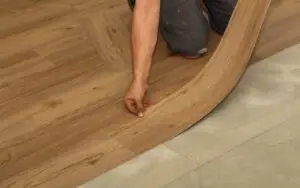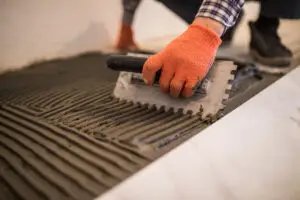Understanding the Basics of Vinyl Plank Flooring Installation
Floating Floor Systems Explained
Vinyl plank flooring is typically installed as a “floating” floor system. This means the planks are not directly adhered to the subfloor but rather interlocked and rest on top of it. This system allows the floor to expand and contract with temperature and humidity changes, reducing the chance of damage and movement. The advantage of this is that the installation is easier and faster, but the correct technique is vital to ensure a stable floor, and this is where professional installers make all the difference.
How Vinyl Planks Lock Together
Vinyl planks use a locking system that allows them to connect securely together without the need for nails or adhesives. This system usually consists of a tongue-and-groove or a click-lock design. These are designed to create a tight fit between the planks, which helps to keep them from shifting or moving. Proper installation is essential for a tight locking system, and this is one of the reasons why it’s beneficial to hire a professional installer.
Key Factors Preventing Vinyl Plank Movement
The Importance of a Level Subfloor
A level subfloor is fundamental for a successful vinyl plank flooring installation. An uneven subfloor can cause the planks to shift, separate, or become damaged over time. It can also affect the locking mechanisms, causing them to fail. Proper subfloor preparation is therefore essential for preventing movement, and a professional will always assess the floor before starting any work.
Uneven Subfloors and Their Impact
Uneven subfloors cause significant issues with vinyl plank flooring. They prevent the planks from locking properly, which makes the floor unstable and vulnerable to shifting and separating. This will eventually lead to further issues, such as gaps, squeaks, or damage. Professional installers have the techniques and tools necessary to prepare the subfloor and create a stable base, making sure your new floor will be stable for many years.
Expansion Gaps and Perimeter Spacing
Expansion gaps are small spaces left around the perimeter of the room. These gaps allow the flooring to expand and contract without putting pressure on the walls or adjacent planks. This is essential to prevent buckling or movement. Understanding the importance of these gaps is one of the reasons that makes professional installers a better choice than trying to do the job yourself.
Why These Gaps Are Crucial
Expansion gaps are essential to prevent the floor from buckling or lifting due to changes in temperature and humidity. Vinyl plank flooring is susceptible to expansion, and without these gaps, it can easily become damaged, causing gaps, squeaks, and more. Professionals are very precise about these measurements, ensuring that your floor will stay stable and beautiful.
The Role of Locking Mechanisms
The locking mechanisms on vinyl plank flooring are designed to hold the planks tightly together. When properly engaged, these mechanisms create a strong connection that prevents movement. Improper installation or damaged locking mechanisms can lead to loose planks and movement. Professional installers have the skills and experience to ensure these mechanisms are properly used for a stable floor.
Click-Lock and Tongue-and-Groove Systems
There are two main types of locking systems: click-lock and tongue-and-groove. Click-lock systems involve fitting the planks together at an angle, while tongue-and-groove systems require one plank to be inserted into the groove of another. Both types are effective at holding the planks together if installed correctly, which is something professionals are always aware of.
Installation Methods and Techniques
Preparing the Subfloor Properly
Preparing the subfloor correctly includes cleaning, leveling, and, in some cases, using underlayment. A clean surface ensures the planks can sit properly, while a level subfloor prevents shifting. Underlayment can add an extra layer of stability and protection. These steps are critical to the overall installation process, and professionals always ensure every step is done to perfection.
Cleaning, Leveling, and Underlayment
Cleaning the subfloor removes debris and dust, which can interfere with the installation. Leveling the subfloor corrects any unevenness, and underlayment provides cushioning and insulation. All these steps are necessary to prepare the floor correctly, which is why hiring a professional is always a better choice.
Installing the First Row Correctly
Installing the first row of planks correctly is crucial, as it is the foundation for the rest of the floor. The first row needs to be straight, level, and aligned with the walls. This step ensures that the rest of the floor will be correctly aligned and that there will be no issues in the long run. Professionals are very precise with this first step, knowing how important it is for the final result.
The Importance of Alignment
The alignment of the first row will dictate how the rest of the floor looks, so any errors made at this stage can result in misaligned rows throughout the rest of the project. Professionals always check and recheck the alignment, which ensures a high-quality, flawless installation.
Connecting Planks Securely
Connecting planks securely involves properly engaging the locking mechanisms. Planks should be pressed firmly together, making sure the joints are tight and even. This will prevent the planks from moving or shifting after the installation is complete, and it’s a task best performed by professionals with the right experience.
Proper Locking Techniques
Proper locking techniques involve using the right amount of force and ensuring the planks are fully engaged. Failing to properly lock the planks together can result in a loose and unstable floor. Professionals have all the right tools and techniques for this task, which is why they are highly recommended for this type of work.
Trimming and Finishing the Edges
Trimming and finishing the edges with transition strips is essential for achieving a polished and professional look. Transition strips cover the expansion gaps and provide a smooth transition between the vinyl planks and adjacent floors. They also protect the edges of the vinyl planks from any damage, which is why they are considered so important by professionals.
Using Transition Strips
Transition strips are installed on the edges of the flooring to cover expansion gaps. They are also used to create a smooth transition between different flooring types. Professionals know how to cut and install these strips for a perfect finish.
Addressing Common Issues with Vinyl Plank Movement
Diagnosing and Fixing Loose Planks
Loose planks can occur if the subfloor is uneven, the locking mechanisms are damaged, or expansion gaps are missing. Diagnosing the problem is the first step in fixing any movement issues, and professional installers can easily identify and fix these problems with their expertise and knowledge.
Preventing Gaps and Buckling
Gaps and buckling are common issues that can arise if the vinyl plank flooring is not properly installed. Using the correct installation techniques, including proper subfloor preparation, expansion gaps, and locked joints, is crucial for preventing these problems, which is why hiring a professional is so important.
Maintaining a Stable and Secure Floor
Maintaining a stable and secure floor involves several steps, such as addressing loose planks promptly, ensuring the floor is free from debris, and not dragging heavy objects over it. This will increase the lifespan of your floor and keep it beautiful and flawless for years to come.
Professional Tips for a Flawless Installation
Professional installers use a number of tips and techniques to ensure a flawless installation. These include using the right tools, taking precise measurements, and paying attention to all the details. Their expertise can make all the difference when it comes to vinyl plank flooring installation.
Professional Vinyl Plank Installation vs. DIY
Case Study 1: Common DIY Installation Mistakes
A homeowner decided to install vinyl plank flooring on his own to save money. They failed to properly level the subfloor and did not leave adequate expansion gaps. As a result, the planks started shifting and separating within a few weeks of installation. They ended up having to hire a professional to remove the entire floor and start all over again, paying more than double what they would have originally paid.
Case Study 2: Benefits of Hiring Professional Installers
Another homeowner decided to hire a professional installer for their vinyl plank flooring. The installer prepared the subfloor perfectly, measured and cut the planks precisely, and properly installed all the transition strips, creating a beautiful and stable floor that looks great and will be stable for many years to come. This case shows that by hiring a professional, you ensure that all the necessary steps are done, giving you a flawless installation.
Risks of Improper Installation Techniques
Improper installation techniques can lead to several risks, such as loose and unstable planks, buckling or lifting, and damaged locking mechanisms, which can end up costing a lot more money in the long run if not dealt with immediately. Professional installations minimize these risks and guarantee a long-lasting floor.
Cost-Effectiveness of Professional Installation
While DIY might seem cheaper initially, the long-term costs of poor installation can be much higher. Hiring a professional ensures that the job is done correctly the first time, avoiding any future repairs and expenses, which saves you money in the long run, making it a very cost-effective solution.
Maintaining Your Vinyl Plank Flooring
Proper Cleaning Techniques
Proper cleaning techniques involve using a damp mop and a neutral floor cleaner. Avoid using abrasive cleaners or excessive water, as this can damage your vinyl plank flooring. Professional installers can advise you on the correct products and techniques for long lasting care.
Protecting Your Floor from Damage
Protecting your floor from damage involves using floor protectors on furniture legs and avoiding dragging heavy objects over the surface. You should also avoid using sharp objects that could scratch the flooring, and it is important to keep the floor clean from debris. This will ensure that your floor looks amazing for a long time.
Addressing Minor Issues Quickly
Addressing minor issues, such as loose planks or small gaps, quickly prevents them from becoming larger problems. This is why regularly inspecting your floor is essential to extend its lifespan and keep it looking beautiful.
Extending the Lifespan of Your Floor
Extending the lifespan of your floor involves maintaining it correctly, addressing any issues promptly, and following the manufacturer’s recommendations, which a professional installer will advise you about. This ensures that you can enjoy your flooring for many years to come.
FAQs & Answers
Vinyl plank flooring, like most flooring materials, expands and contracts with temperature and humidity changes. Expansion gaps around the perimeter of the room allow the floor to move without putting pressure on the walls or adjacent planks, preventing buckling, gaps, and other issues. Professional installers are always careful to install these gaps correctly, ensuring that the floor can expand and contract as needed. Therefore, hiring professionals is often the safest way to guarantee a stable floor with no issues.
An uneven subfloor can cause significant problems with vinyl plank flooring. It can result in planks not locking together properly, leading to movement, squeaking, and even damage to the locking mechanisms. Professional installers always ensure the subfloor is properly prepared, using leveling compounds and techniques to create a stable and even surface for the new floor, which ensures there will be no issues in the long run. This is a key part of what professionals bring to the table, and it's what guarantees a stable floor.
The locking mechanism is crucial for keeping vinyl plank flooring from moving. It creates a secure and tight bond between the planks, preventing them from shifting, separating, or moving over time. Professional installers have the expertise to properly engage the locking mechanism, ensuring that each plank is securely in place and that the floor is stable and will not have any issues for a very long time. This attention to detail is a key reason to hire a professional.
Yes, you can attempt to fix vinyl plank flooring that is already moving, but the success of the fix will depend on the underlying cause of the movement. Issues like an uneven subfloor, inadequate expansion gaps, or improperly locked planks are often the root cause of this. Professional flooring installers are able to quickly identify these issues and apply the correct solutions to guarantee a stable floor. Moreover, they also have the tools and knowledge to fix the most complex issues without causing further damage.
Choosing a professional for vinyl plank flooring installation guarantees that the job is done correctly, with all the necessary steps and precautions taken to ensure a beautiful and long-lasting floor. Professionals have years of experience, the right tools, and the expertise to handle the most complex installations. By ensuring a level subfloor, proper locking mechanisms, and accurate expansion gaps, they make sure there are no issues in the future. Hiring a professional not only saves you time and stress, but also guarantees that your floor is installed flawlessly, making it a worthwhile investment.





